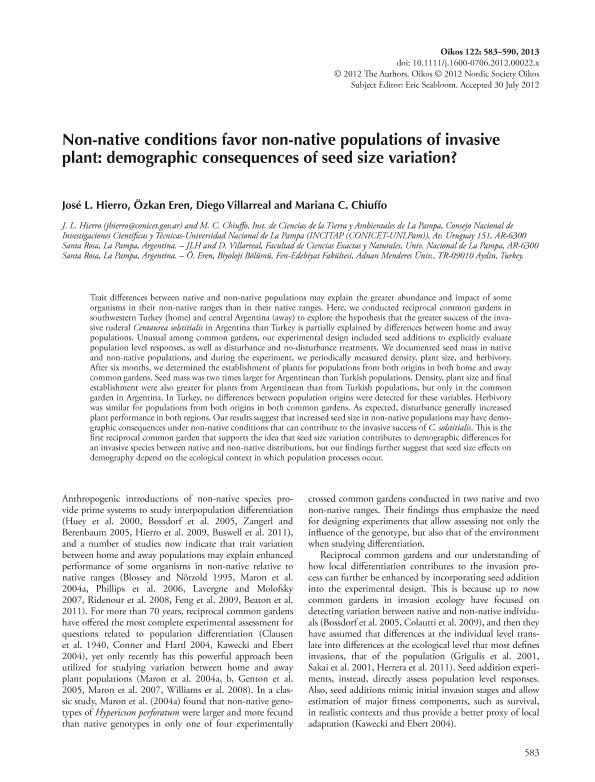Mostrar el registro sencillo del ítem
dc.contributor.author
Hierro, Jose Luis

dc.contributor.author
Eren, Özkan
dc.contributor.author
Villarreal, Diego
dc.contributor.author
Chiuffo, Mariana Cecilia

dc.date.available
2017-06-29T15:52:12Z
dc.date.issued
2013-04
dc.identifier.citation
Hierro, Jose Luis; Eren, Özkan; Villarreal, Diego; Chiuffo, Mariana Cecilia; Non-native conditions favor non-native populations of invasive plant: demographic consequences of seed size variation?; Wiley; Oikos; 122; 4; 4-2013; 583-590
dc.identifier.issn
0030-1299
dc.identifier.uri
http://hdl.handle.net/11336/19127
dc.description.abstract
Trait differences between native and non-native populations may explain the greater abundance and impact of some organisms in their non-native ranges than in their native ranges. Here, we conducted reciprocal common gardens in southwestern Turkey (home) and central Argentina (away) to explore the hypothesis that the greater success of the invasive ruderal Centaurea solstitialis in Argentina than Turkey is partially explained by differences between home and away populations. Unusual among common gardens, our experimental design included seed additions to explicitly evaluate population level responses, as well as disturbance and no-disturbance treatments. We documented seed mass in native and non-native populations, and during the experiment, we periodically measured density, plant size, and herbivory. After six months, we determined the establishment of plants for populations from both origins in both home and away common gardens. Seed mass was two times larger for Argentinean than Turkish populations. Density, plant size and final establishment were also greater for plants from Argentinean than from Turkish populations, but only in the common garden in Argentina. In Turkey, no differences between population origins were detected for these variables. Herbivory was similar for populations from both origins in both common gardens. As expected, disturbance generally increased plant performance in both regions. Our results suggest that increased seed size in non-native populations may have demographic consequences under non-native conditions that can contribute to the invasive success of C. solstitialis. This is the first reciprocal common garden that supports the idea that seed size variation contributes to demographic differences for an invasive species between native and non-native distributions, but our findings further suggest that seed size effects on demography depend on the ecological context in which population processes occur.
dc.format
application/pdf
dc.language.iso
eng
dc.publisher
Wiley

dc.rights
info:eu-repo/semantics/openAccess
dc.rights.uri
https://creativecommons.org/licenses/by-nc-sa/2.5/ar/
dc.subject
Seed Size
dc.subject
Non Natives
dc.subject
Biogeographic Comparison
dc.subject.classification
Otras Ciencias de la Tierra y relacionadas con el Medio Ambiente

dc.subject.classification
Ciencias de la Tierra y relacionadas con el Medio Ambiente

dc.subject.classification
CIENCIAS NATURALES Y EXACTAS

dc.title
Non-native conditions favor non-native populations of invasive plant: demographic consequences of seed size variation?
dc.type
info:eu-repo/semantics/article
dc.type
info:ar-repo/semantics/artículo
dc.type
info:eu-repo/semantics/publishedVersion
dc.date.updated
2017-06-29T13:57:46Z
dc.identifier.eissn
1600-0706
dc.journal.volume
122
dc.journal.number
4
dc.journal.pagination
583-590
dc.journal.pais
Estados Unidos

dc.journal.ciudad
Hoboken
dc.description.fil
Fil: Hierro, Jose Luis. Consejo Nacional de Investigaciones Científicas y Técnicas. Instituto de Ciencias de la Tierra y Ambientales de la Pampa. Universidad Nacional de la Pampa. Facultad de Cs.exactas y Naturales. Instituto de Ciencias de la Tierra y Ambientales de la Pampa; Argentina
dc.description.fil
Fil: Eren, Özkan. Adnan Menderes Universitesi; Turquía
dc.description.fil
Fil: Villarreal, Diego. Universidad Nacional de La Pampa; Argentina
dc.description.fil
Fil: Chiuffo, Mariana Cecilia. Consejo Nacional de Investigaciones Científicas y Técnicas. Instituto de Ciencias de la Tierra y Ambientales de la Pampa. Universidad Nacional de la Pampa. Facultad de Cs.exactas y Naturales. Instituto de Ciencias de la Tierra y Ambientales de la Pampa; Argentina
dc.journal.title
Oikos

dc.relation.alternativeid
info:eu-repo/semantics/altIdentifier/doi/http://dx.doi.org/10.1111/j.1600-0706.2012.00022.x
dc.relation.alternativeid
info:eu-repo/semantics/altIdentifier/url/http://onlinelibrary.wiley.com/doi/10.1111/j.1600-0706.2012.00022.x/abstract
Archivos asociados
